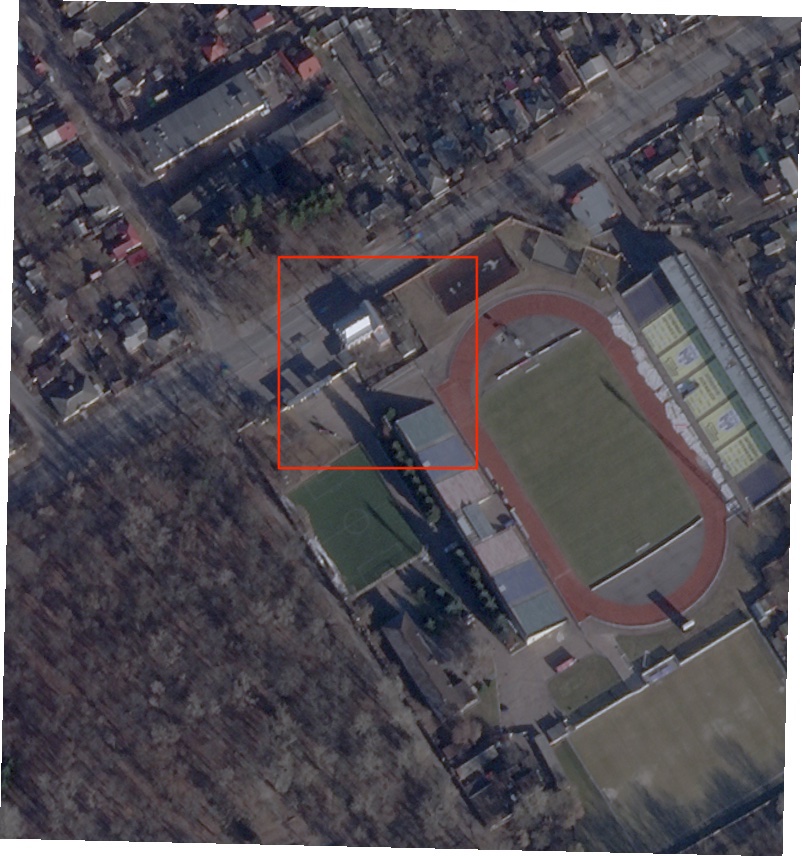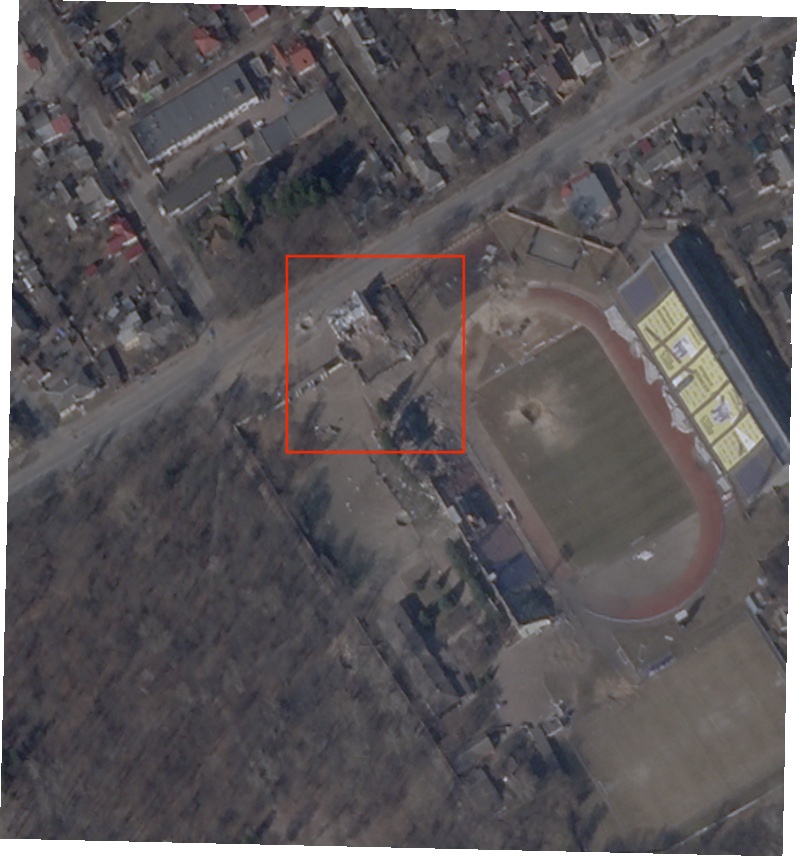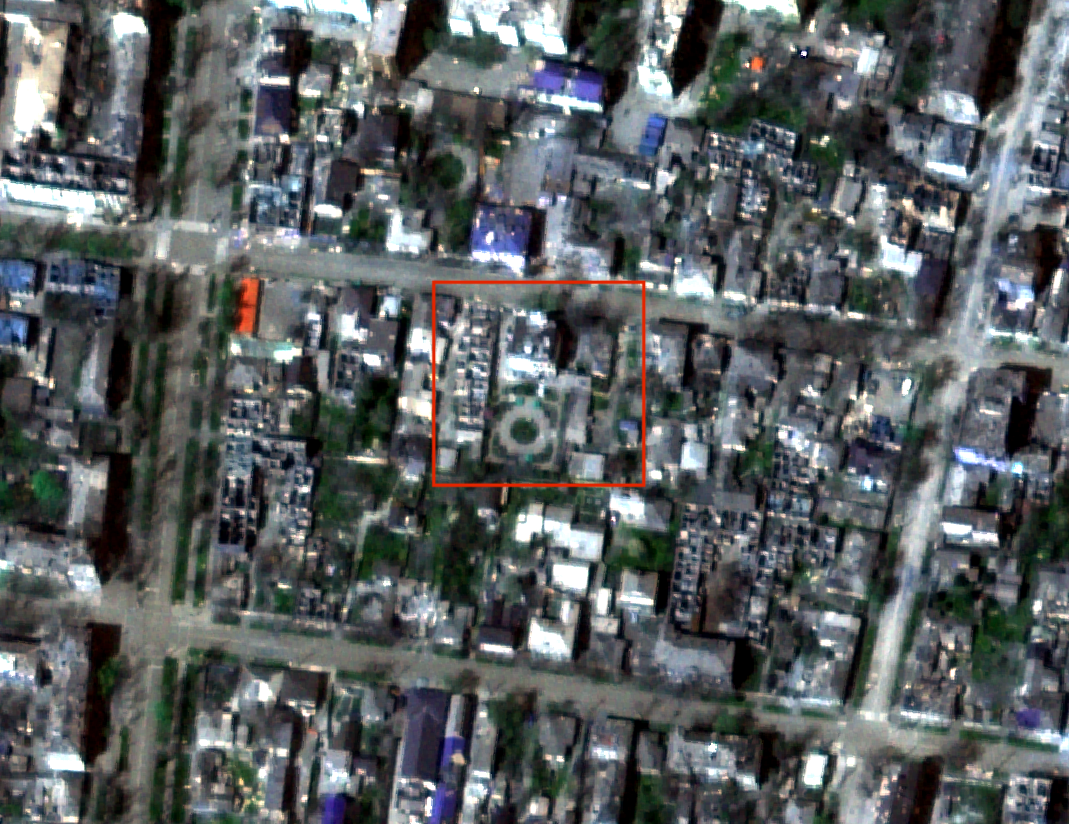Clues to the Fate of Five Damaged Cultural Heritage Sites in Ukraine
Ever since Russia launched its invasion of Ukraine, the country’s curators and historians have busied themselves moving artefacts and works of art out of harm’s way. The stained glass windows of Lviv’s cathedral are now secured behind metal. Pyramids of sandbags protect statues in downtown Odesa. An army of online volunteers is even backing up the digital archives of the country’s museums.
But there are hundreds of sites across Ukraine which cannot be moved or protected in this way. Museums, churches, cemeteries and historic buildings are at risk of missile attacks, artillery and small arms fire. Although none of the country’s six (cultural) UNESCO World Heritage Sites have yet been hit, the UN agency has announced that at least 139 cultural sites have been damaged in some way during Russian President Vladimir Putin’s war on Ukraine.
Putin’s decision to call into question Ukraine’s identity and statehood has raised the destruction of cultural heritage well beyond a niche issue – in fact, some Ukrainians see it as evidence of a campaign of cultural erasure.
“You clearly see that there is a plan to erase Ukrainian identity and culture if needed, together with Ukrainians physically. That’s not a question. When you look from Kyiv it looks like a deliberate action to get rid of anything which makes Ukrainian otherness from Russia”, said Olesia Ostrovska-Liuta, director of the Arsenal Cultural Centre in the Ukrainian capital.
It is often hard to conclusively establish intent and motivation behind incidents or attacks that have led to the damage or destruction of cultural sites – especially through open sources alone. If attacks on historic buildings are deliberate, that could amount to a war crime. What can be said is that the sheer number of cultural sites damaged or under threat indicates that it is highly unlikely they are being excluded from Russia’s bombardment.
In some instances, cultural sites that were being used to shelter civilians have been struck.
Bellingcat and its partner, Newsy, looked at several Ukrainian heritage sites that have been attacked or bombed during Russia’s invasion, but which have not yet received widespread attention in international media. The aim was to see what open source could tell us about the condition of the sites and the circumstances that led to their damage and destruction.
Most are smaller sites in the country’s East which will likely be lesser known to international audiences – though that does not make their loss any less significant to local Ukrainians.
We chose to focus on incidents where there appeared to be a reasonable amount of open source evidence and data available. It is important to note that many, many other sites have been reported damaged or destroyed. However, analysing them all in detail would take significantly more resources than currently available to Bellingcat and Newsy.
Still, the examples chosen emphasise the diversity and splendour of Ukraine’s rich cultural history and are representative of the dangers facing, or already inflicted upon, sites of significance across the country.
They also show how open source data can be gathered to detail the extent of damage and destruction in areas it may be too dangerous to venture, as well as potentially identify who or what was responsible for attacks on sites of cultural significance in some instances.
Sviatohirsk Lavra Monastery
On March 12, this historic Orthodox monastery was reportedly hit by an airstrike which shattered the windows and doors of its dormitories and damaged church buildings. It would be the first of many attacks on this site and several churches under its jurisdiction.
This stunning monastery lies in wooded hills in the north of the Donetsk Region, and on the banks of the Siverskyi Donets River. It is a ‘Lavra’, a cave monastery, and a major pilgrimage site affiliated with the Ukrainian Orthodox Church of the Moscow Patriarchate.
At the time of writing, the site remains very close to the frontline in the Donbas.
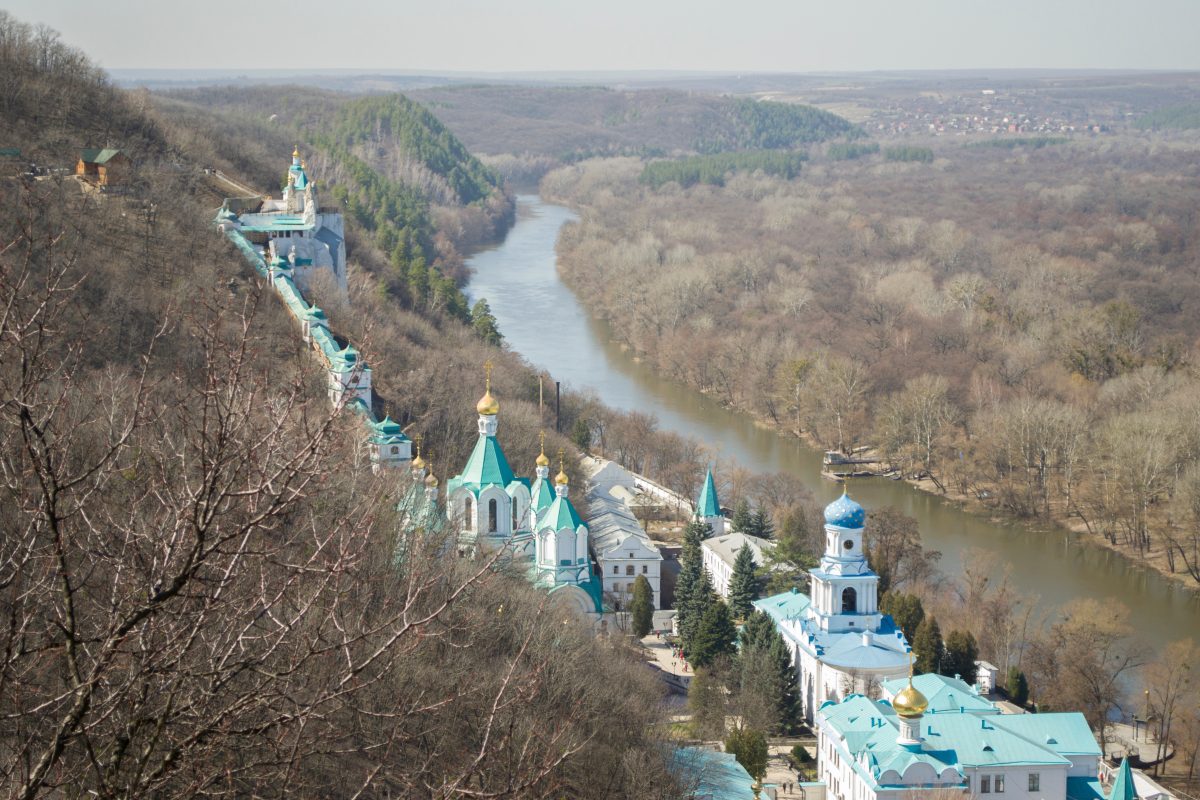
Sviatohirsk Lavra or the Sviatohirsk Cave Monastery. View from Mount Artyom to Svyatogorsk Lavra standing on the banks of the Severskyi Donets River at the Sviatohori National Nature Park in early spring. Photo (c): Vitusia / 123RF Images. All rights reserved.
In a video announcement on March 13, the monastery’s press office stated that the bomb landed near a bridge spanning the Donets river which connects the monastery grounds to the town of Sviatohirsk. Approximately 520 refugees from Kharkiv and Izyum were sheltering at the dormitories, noted Metropolitan Arseniy, a senior cleric. “There were no military formations on the monastery grounds nor in the city. The airstrike hit a peaceful town,” he stressed.
Images released by the monastery the day after the attack showed that buildings nearest to where the Donets river bridge connects to the complex received the most damage.
The windows of church buildings as far away as 270 metres from the bridge were also damaged, including the monastery’s large cathedral building which also suffered some damage to the moulding on one of the building’s towers.
At least one video released the night of the incident can be geolocated to the other side of the bridge where damage to a restaurant can be seen.
While the monastery published a large amount of photos of the damage from the blast on Flickr, there was no imagery showing any munition remnants. Bellingcat and Newsy emailed the monastery to inquire if any images of remnants were available but received no response by the time of publication.
Despite the monastery’s claim that the bomb landed near the bridge, there are no visuals showing significant damage to the bridge itself. However, an important clue could be a group of pine trees near where the majority of damage was caused – their tops appear to be cut and burned, suggesting that they may have detonated whatever munition was used.
The monastery was reportedly hit again by more shelling on May 4. Both the church and Donetsk Prosecutor’s Office shared images of the incident, although the building damage in the images is the same as what was seen after the March explosion. The photos do show that temporary window coverings were damaged, and the monastery says interior parts of the complex were damaged. According to the prosecutor’s office, seven people were injured.
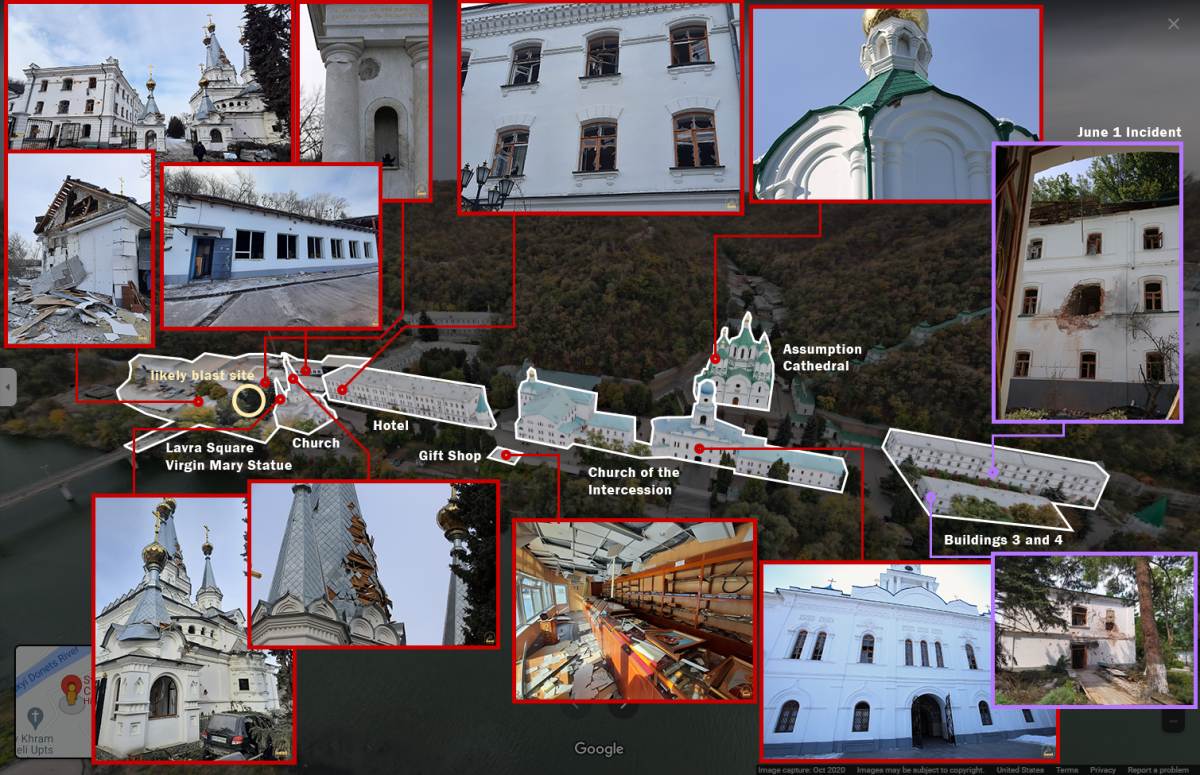
On April 29, Russian Colonel-General Mikhail Mizintsev claimed that Ukrainian forces had placed weapons systems in the region of the monastery, though did not specify near which exact structure. Older footage from March showed two Russian strikes against unidentified heavy vehicles near the St. George’s Church in Dolyna, which is approximately 10 km from the Lavra itself.
No such footage has been made available showing military equipment anywhere else near religious buildings. In any case, Mizintsev offered no evidence of his claims nor could Bellingcat discover any imagery online that would support them.
While its primary complex is immediately across the river from the town of Sviatohirsk, the monastery has other nearby religious sites that it also considers part of its jurisdiction. These buildings have also been damaged in attacks throughout May and June.
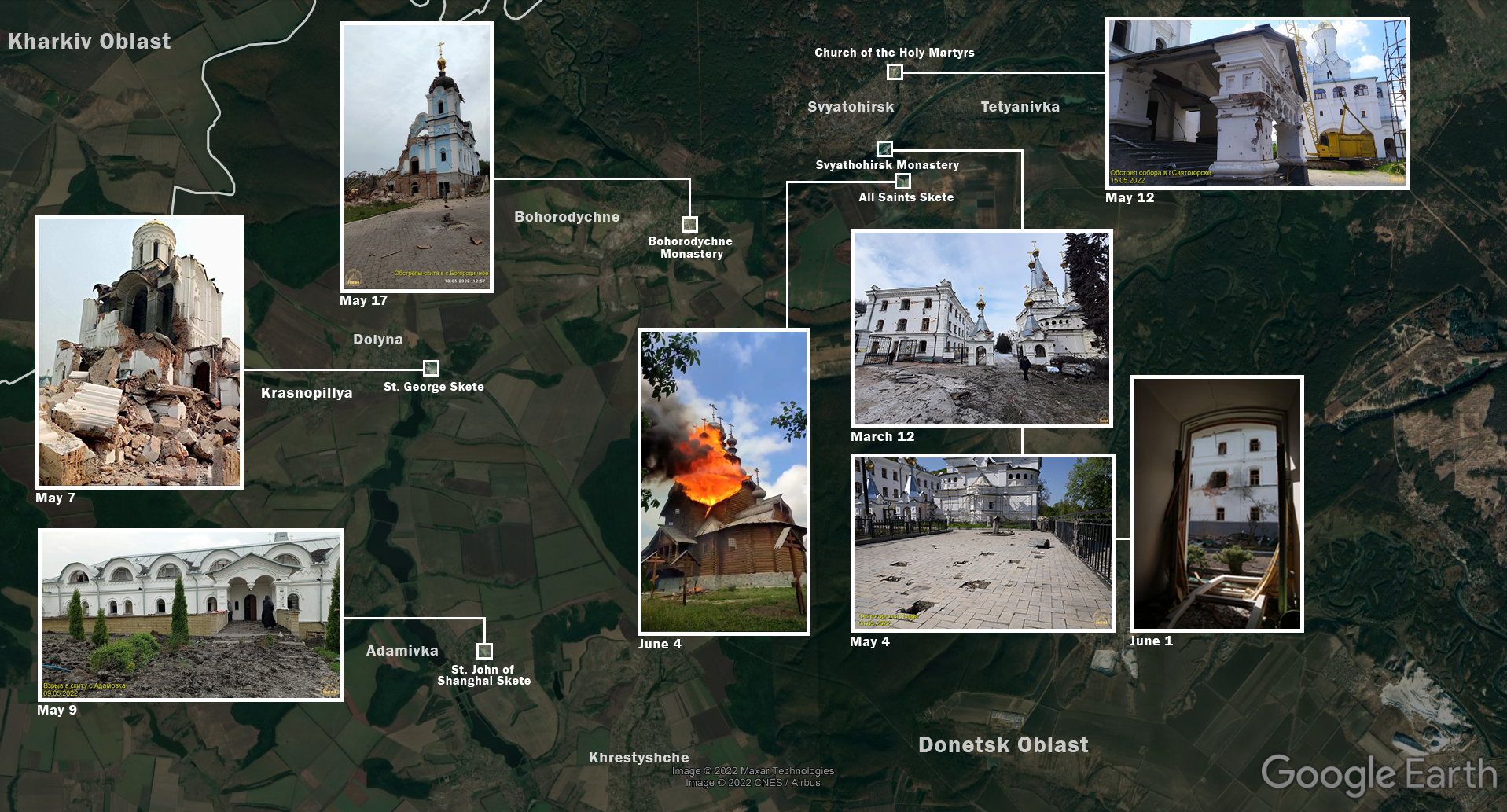
These include the St. George’s Monastery in Dolyna on May 7, the St. John of Shanghai Monastery in Adamivka on May 9, the Church of Holy Martyrs in Sviatohirsk on May 12 and the Bohorodychne Monastery on May 17.
On June 1, the main building of the Lavra was bombed again.
Perhaps one of the most discussed incidents came on June 4, when the All Saints’ Church – on a hill to the south of the main Lavra complex – was set ablaze.
https://twitter.com/agathaxgorski/status/1533060697382342657
An image posted by the Donetsk Diocese to Facebook, which may have originally been taken by Ukrainian media outlet Hromadske, showed fire billowing from its roof at 12:45. By 17:03, a video posted to Telegram and geolocated by Bellingcat showed the site of this church building, of which, once debris had been cleared, only stone foundations remained. NASA FIRMS data also appeared to show fire activity at the site.
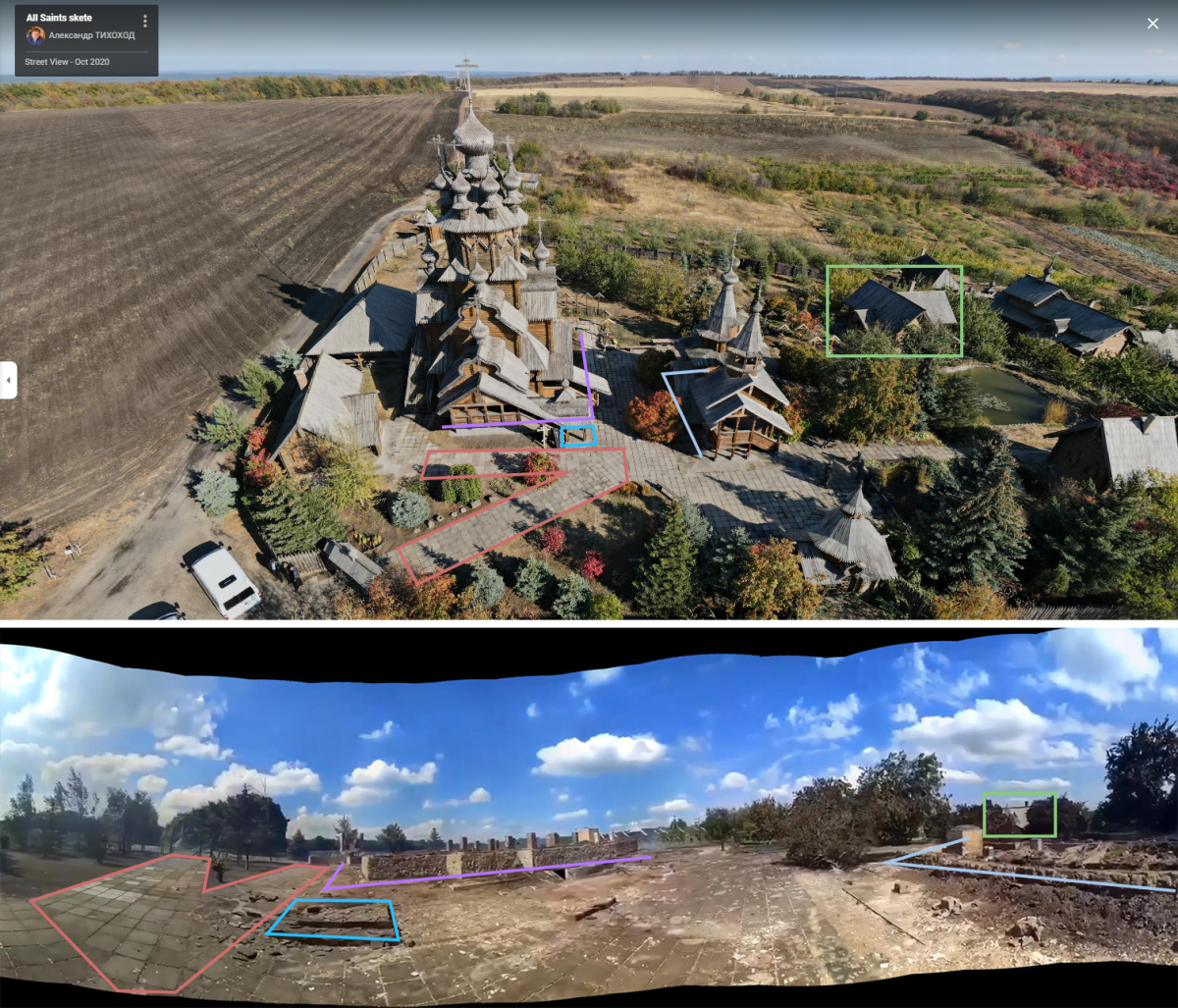
Zelensky stated that the church had been destroyed by Russian artillery shelling, which he claimed had been observed by monks.
However, the Russian Ministry of Defence denied it had attacked the Lavra, asserting that the wooden church had been set alight by “Ukrainian nationalists” as they fled south from Sviatohirsk.
At the time of writing, the situation around Sviatohirsk remains fluid. On June 6, the Russian Ministry of Defence claimed that it had “completed the liberation of Sviatohirsk” and destroyed the bridge over the Severnyi Donets River near the Lavra. Open source imagery appears to confirm this: a local’s video published on June 5 shows the bridge still standing, while it is destroyed in footage published on June 7.
On June 7, a video also surfaced in local Telegram groups in which a man introducing himself as the Mayor of Sviatohirsk Volodymyr Bandura repeats pro-Russian talking points and blames the Ukrainian military for the burning of a church in the nearby village of Tetyanivka, presumably the All Saints’ Church. Local media and residents have speculated that Bandura may have made the statements under duress.
Skovoroda Museum, Skovorodynivka
On May 6, a strike destroyed the Hryhoriy Skovoroda Museum in the village of Skovorodynivka in the Kharkiv Region. “Targeted strikes against museums – not even terrorists would think of this. But this is the kind of army we are fighting against”, said Ukrainian President Volodymyr Zelensky after the attack.
This small museum was dedicated to Hryhoriy Skovoroda, a Ukrainian philosopher and theologian who died in the village of Ivanovka in 1794, which was later renamed to Skovorodynivka in his honour. Given the prominence of Skovoroda – his likeness adorns Ukraine’s 500 Hryvnia banknote – the destruction of this small museum was highly symbolic for many Ukrainians and some opposition-minded Russians.
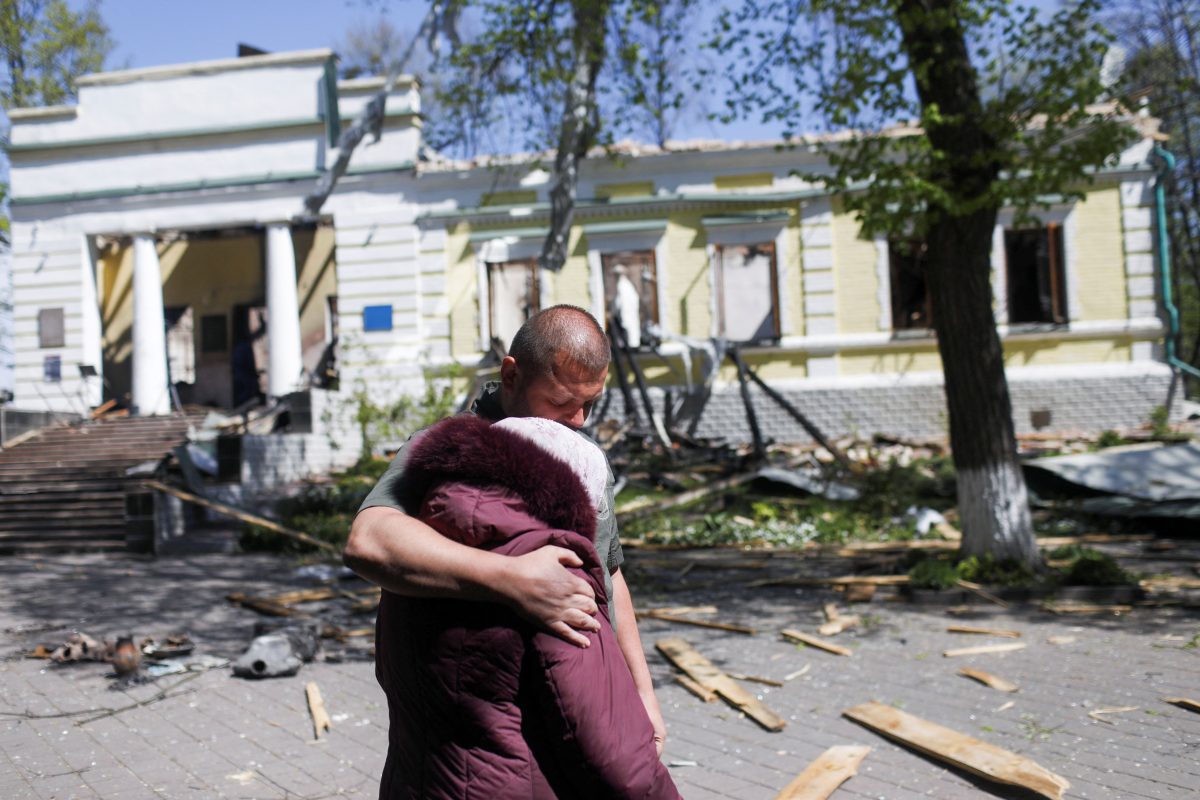
Employees react after a Russian bombing hit the Hryhoriy Skovoroda Literary Memorial Museum, amid Russia’s attack on Ukraine, in Skovorodynivka village near Kharkiv, Ukraine, May 7, 2022. REUTERS/Ricardo Moraes
President Zelensky even mentioned the museum in his Victory Day address on May 9, declaring that the Russians “believe their missiles can destroy our philosophy”.
So what can we discover about what happened?
At approximately 00:30 on May 7, videos appeared on Telegram channels showing the building ablaze. According to the news website Suspilne, which shared a video of the burning museum just ten minutes later, a Russian missile is reported to have hit the roof of the building and caused a fire. At 06:55, the Kharkiv Regional State Emergency Service posted an account of their night’s work to Facebook, stating that a shell had hit the museum at 23:10, causing a fire which engulfed the surrounding area and was not fully extinguished until 08:00 the next day.
Once the building was safe to enter, numerous images and videos from its interior appeared online – some taken by Ukrainian criminal investigators and police. The museum was missing its roof and many windows; practically all interior furnishings and decorations have been destroyed.
As Bellingcat could not see munition fragments in these photos of the aftermath, it is not possible to confirm the weapons system used solely through open sources. However, the incentive for one side to attack can potentially be inferred by establishing who had operational control of the area at the time.
According to maps compiled by open source researcher Nathan Ruser of the Australian Strategic Policy Institute (ASPI), the village of Skovorodynivka was under Ukrainian control as of May 6, thus it is highly unlikely to have been attacked by those same Ukrainian forces. This is further indicated by the arrival of Ukrainian journalists and emergency services at the museum within an hour of the attack.
Shortly after the fire was extinguished, Deputy Director of the Museum Olena Rybka wrote on Facebook that while the losses to the museum were enormous, many of its contents had been evacuated beforehand. The governor of Kharkiv Oblast, Oleh Synehubov, also wrote on Telegram that the most valuable exhibits had survived — however, a 35-year old watchman was injured.
Several images from the destroyed museum have since become emblematic of the cultural destruction observed in recent months. Among them are images of a bust and statue of Skovoroda inside the charred museum. For several prominent Ukrainian commentators, the statues’ survival is a sign of defiance.
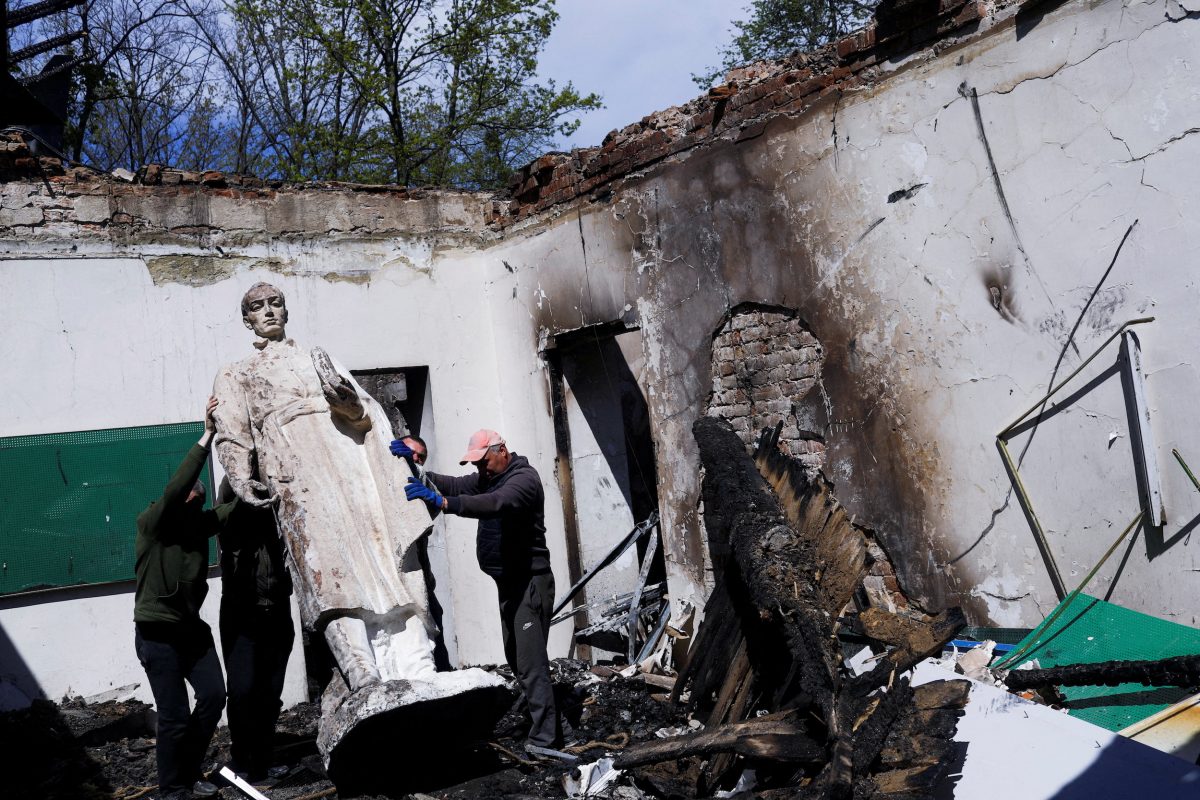
Employees remove the statue of Ukrainian philosopher Hryhoriy Skovoroda after a Russian bombing hit the Hryhoriy Skovoroda Literary Memorial Museum, amid Russia’s attack on Ukraine, in Skovorodynivka village near Kharkiv, Ukraine, May 7, 2022. REUTERS/Ricardo Moraes TPX
Tarnovsky House and Library, Chernihiv
The historic city of Chernihiv was subject to an intense siege by Russian forces until their withdrawal from northern Ukraine.
On March 11, reports surfaced that the Tarnovsky Building, home to the city’s youth library, had been destroyed. The adjacent Haharyna Stadium was also heavily damaged.
This historic building is so named because until 1925 it housed the collection of Vasyl Tarnovsky, a prominent Chernihiv citizen who founded the city’s Museum of Ukrainian Antiquities.
After the explosion, governor of the Chernihiv Region Vyacheslav Chaus was one of the first on the scene. He posted a video to his Telegram channel at 07:00 local time from just outside the library, with a crater visible behind him. “A stadium and a library. Such strategic objects”, he remarked caustically.
Images then appeared online showing collapsed bookshelves inside the shattered building, which sustained serious structural damage.
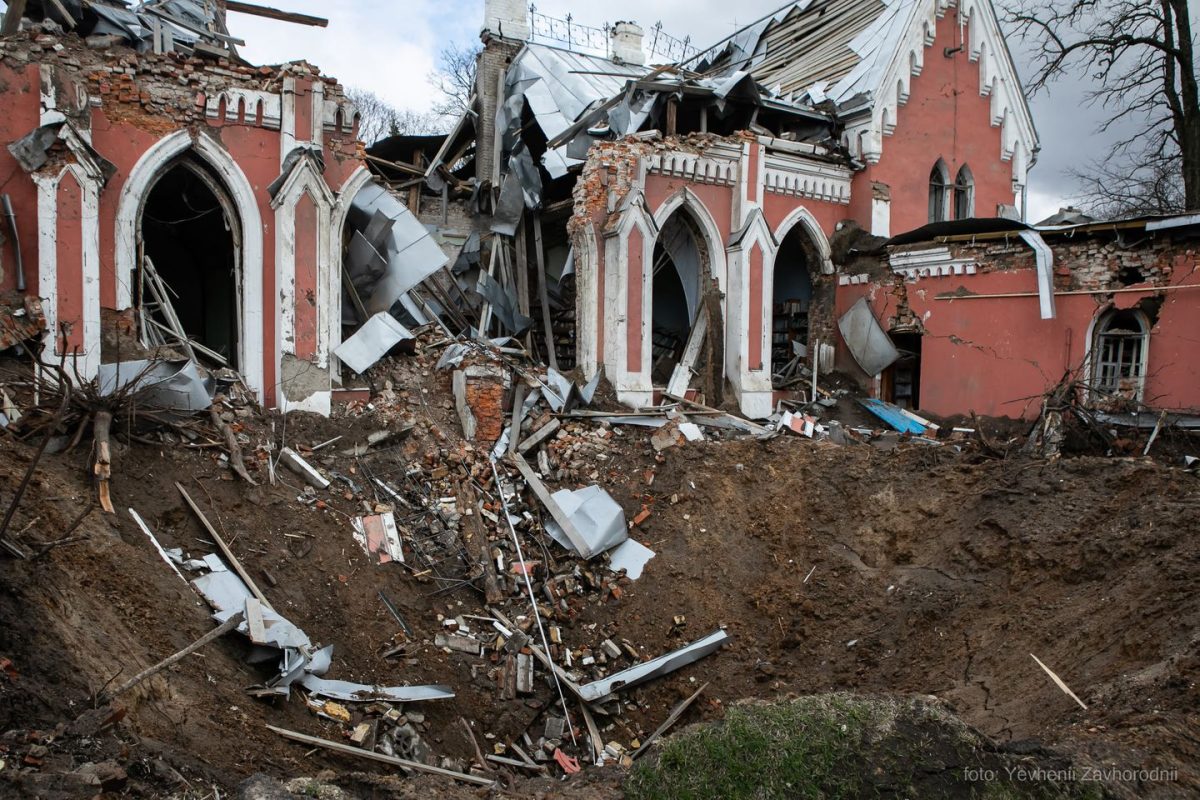
Image of a crater behind the Tarnovsky Building in Chernihiv taken by photojournalist Yevhenii Zavorodnii and shared on Facebook. Published with permission.
One photo by Associated Press photojournalist Emilio Morenatti showing a Ukrainian firefighter rescuing books from the Tarnovsky Building on World Book Day (April 23) went viral on Twitter.
An April 11 video of destroyed cultural sites in Chernihiv taken by Suspilne, a Ukrainian news website, stated that “three high-explosive 500 kg bombs” were dropped on the immediate area on the night [i.e. very early morning] of March 11. “The most damage was done by the bomb which landed by the entrance to the library, which destroyed the wall and internal support beams”, it continued.
This is consistent with open source imagery of the craters. For an illustration of their size, the following images posted on Telegram of individuals standing in them allow for a calculation (crater in the stadium, crater outside the library). A further video posted to Facebook shows the depth of the smaller crater on the main road outside the Tarnovsky Library. Assuming the height of an adult male between 1.5 to 1.9 metres, these craters must be at the very least three or four metres deep.
The craters can be clearly seen on Planet satellite imagery obtained by Bellingcat before (February 28) and after (March 18) the attack:
An airstrike would be consistent with the military situation around the city as of March 11. According to international media such as Al Jazeera, Chernihiv was near-encircled by Russian forces and suffered multiple airstrikes.
Unexploded FAB-500s – a Soviet-manufactured 500 kg air-dropped bomb – do appear to have been found across Chernihiv since the Russian offensive on the city. On March 3, Ukraine’s Foreign Minister Dmytro Kuleba shared an image on Twitter of what strongly resembled a bomb from the FAB-500 series which he claimed had fallen in a residential area of Chernihiv. This image was apparently supplied by Governor Chaus, who was the source for its appearance in international media reports on Chernihiv. Moreover, a EuroNews report from March 10, a day before the destruction of the Tarnovsky library, shows Ukrainian emergency services in Chernihiv seemingly defusing the same type of bomb. However, the available open source information alone is, at this stage, not enough to establish the munition that was used for the attack on the library.
Serhiy Laevskyi, director of the Chernihiv Historical Museum, noted in a March 11 Facebook post that the Tarnovsky building had survived attacks by the Bolsheviks in 1918-1919 and the bombs of Nazi invaders in the Second World War – but has now been “wrecked” by the Russian army.
Kuindzhi Museum, Mariupol
Mariupol’s Kuindzhi Art Museum is located a couple of blocks away from the city’s destroyed Drama Theatre, in which hundreds were killed by a Russian airstrike on March 16. The museum commemorates the work of Arkhip Kuindzhi , an ethnic Greek landscape painter who was born in the nearby Pryozivia region.
On March 23, Mariupol’s City Council announced that the Kuindzhi Museum had been “destroyed” by a Russian bomb. For several weeks thereafter Ukrainian media were not able to provide imagery showing the scale of damage to the museum. The city is now under Russian control.
Bellingcat obtained Planet satellite imagery taken on April 24 which suggests that the building had suffered some damage but had not been completely razed. Its roof sustained less damage than buildings in the immediate vicinity which had been entirely destroyed.
The slider below compares the April 24 imagery with Maxar satellite imagery, accessed via Google Maps, from May 2020:
Accounts of the museum’s destruction initially varied. On March 21, two days before Mariupol’s City Council announced its destruction, the Head of Ukraine’s Union of Artists Konstantin Chernyavsky said that a Russian airstrike had destroyed the Kuindzhi Museum.
Chernyavsky also noted that the museum’s collections held three original works by the artist, none of which were in the building at the time of the attack. Their fate was the cause of much concern. Petro Andryushchenko, an advisor to Mariupol’s Mayor, claimed in a Telegram post on April 27 that the three paintings had been “handed over” to the Russian occupiers by Nataliya Kapusnikova, director of the nearby Museum of Local Lore which was also damaged during fighting.
On April 27, Kapusnikova stated to pro-Kremlin Russian news outlet Izvestiya in an interview conducted on the grounds of the museum that the paintings were indeed safe.
The next day, the Russian TV station Panorama broadcast an interview with the director about the fate of the paintings, in which she showed Kuindzhi’s ‘Red Sunset’ alongside a work by the famous Russian-Armenian painter Ivan Aivazovsky which she had also hid in her apartment. A 1915 portrait of Kuindzhi feeding pigeons by a contemporary was also discovered in the building’s cellar.
A handwritten sign at the front door declares that the Kuindzhi Museum is now under the purview of the DNR’s “Ministry of Culture”. Its employees appear to have been present during the Panorama interview with Kapusnikova.
The Panorama and Izvestiya news broadcasts provided the first close-up, visual evidence as to the current condition of the Kuindzhi Museum.
In one frame of the Izvestiya video, a hole can be seen on the eastern wall of the building. This same hole can later be seen from inside the museum.
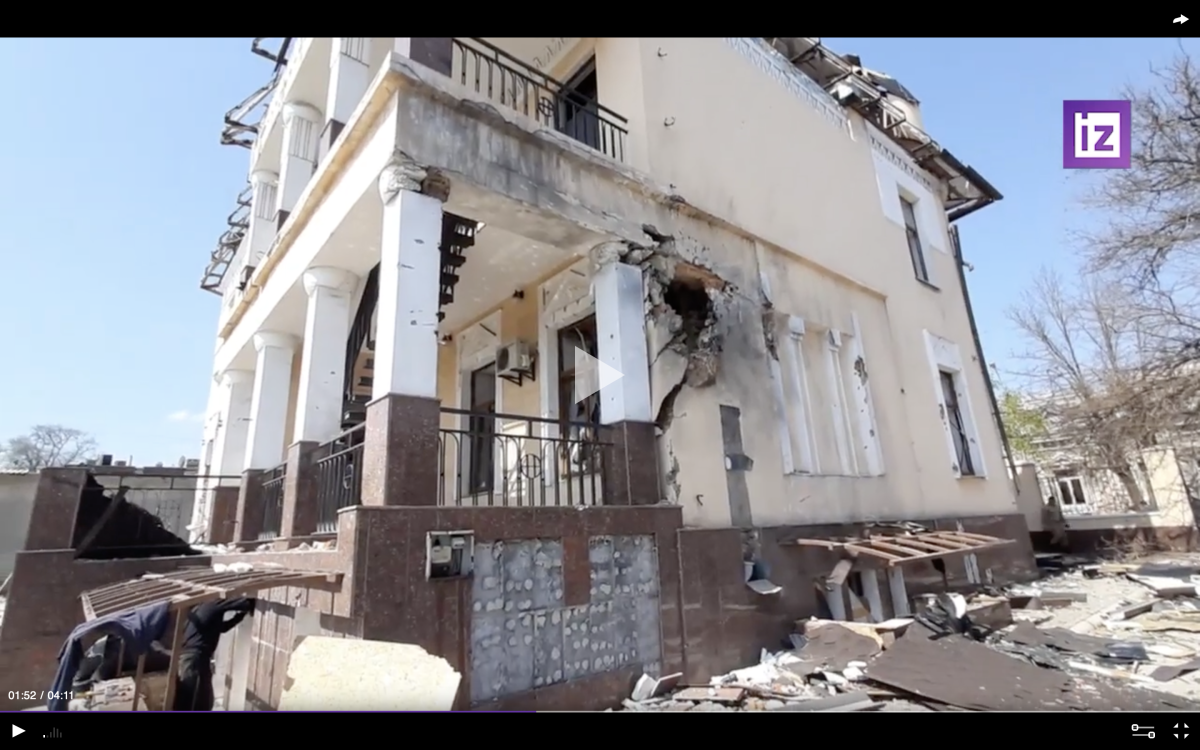
Eastern facade of the Kuindzhi Museum in Mariupol (Izvestiya news video, April 27)
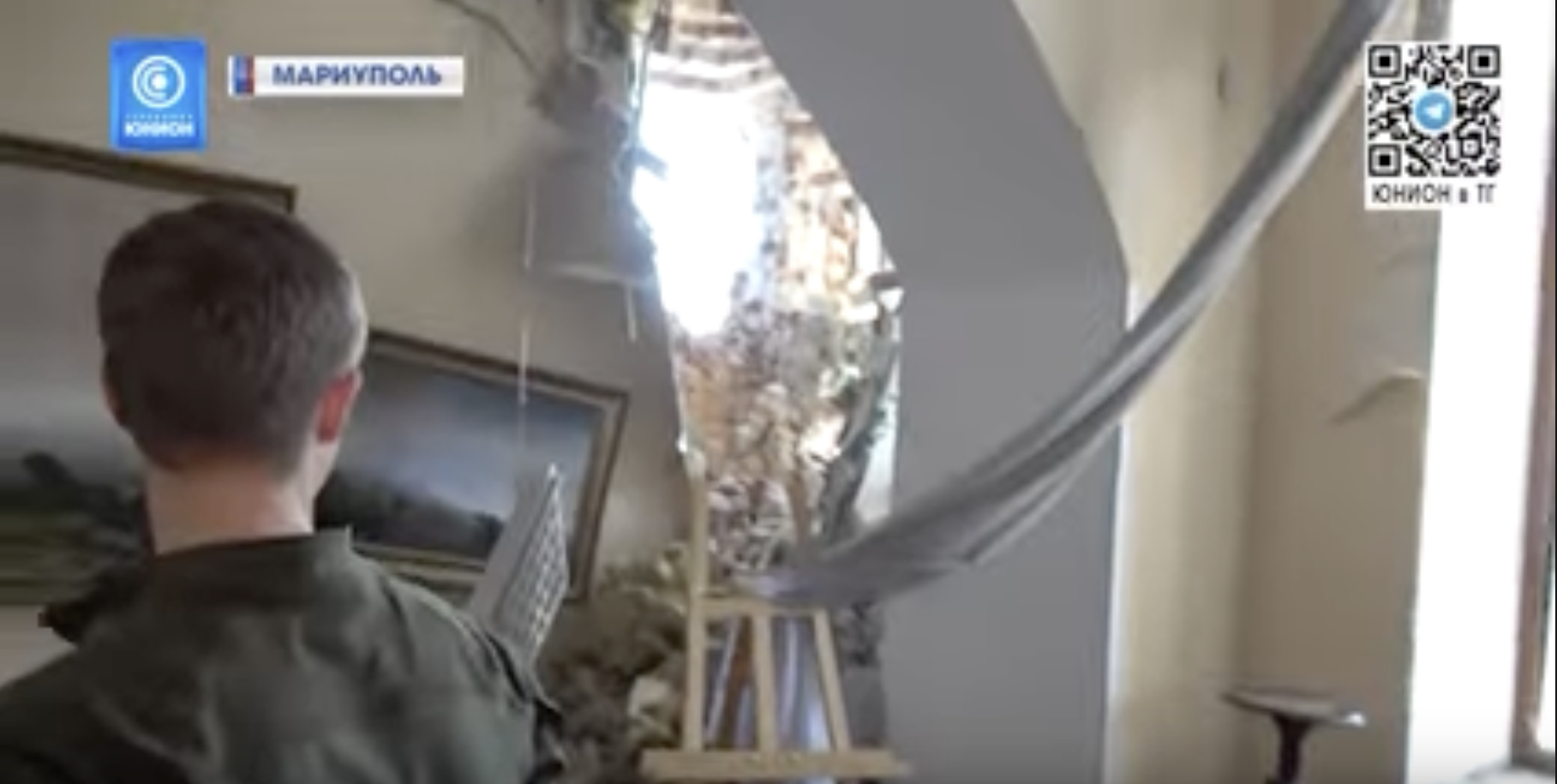
Hole in the facade of the Kuindzhi Museum in Mariupol, seen from within (Panorama news video, April 28)
Given that shrapnel remains cannot be clearly seen in either of these videos, it is not possible to determine the precise weapon system used.
Further imagery surfaced online in an article by The Village, an independent Ukrainian publication, on May 15. The report claimed that the original Kuindzhi paintings are now in the possession of the Regional Museum of Local History in Donetsk. It also includes an image of the back of the Kuindzhi Museum after the attack. This provided evidence of additional damage, alongside the hole in the eastern wall.
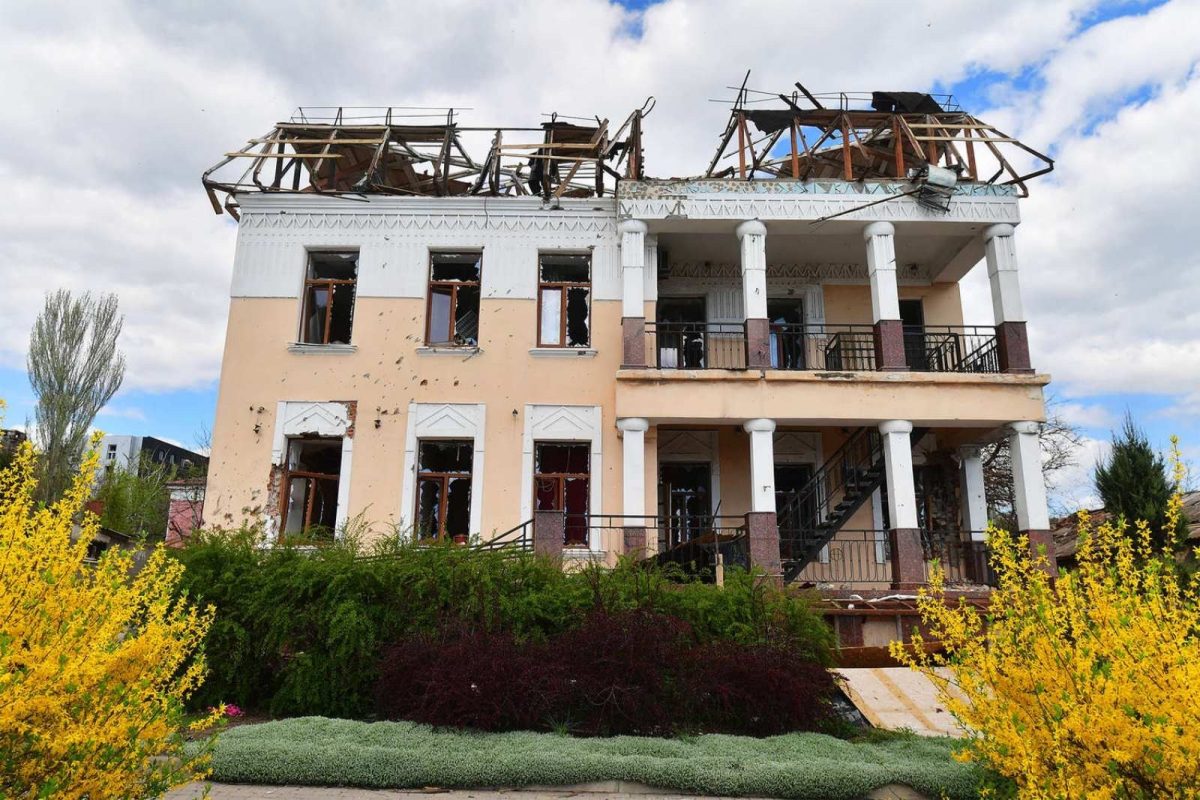
Image of damage to the Kuindzhi Museum as included in The Village Ukraine’s article, republished with permission.
A shrapnel scatter pattern can be also seen on the left-hand side of the building, indicating an explosion at ground level nearby. Extensive damage to the roof can be seen – something the satellite imagery shown earlier was unable to establish due to its low resolution.
Popov’s Palace Complex, Vasylivka
On the southern bank of one of the widest points of the River Dnieper lies the town of Vasylivka, the location of Popov’s Palace. This eclectic manor house, completed in 1894, was named for the local nobles who ruled this area until 1917. The building now functions as a local history museum.
The town lies upriver from Enerhodar, site of Ukraine’s largest nuclear power plant, and downriver from the strategically important city of Zaporizhzhia. It came under Russian occupation in early March, as the southern front of the invasion advanced rapidly into the Kherson and Zaporizhzhia Regions.
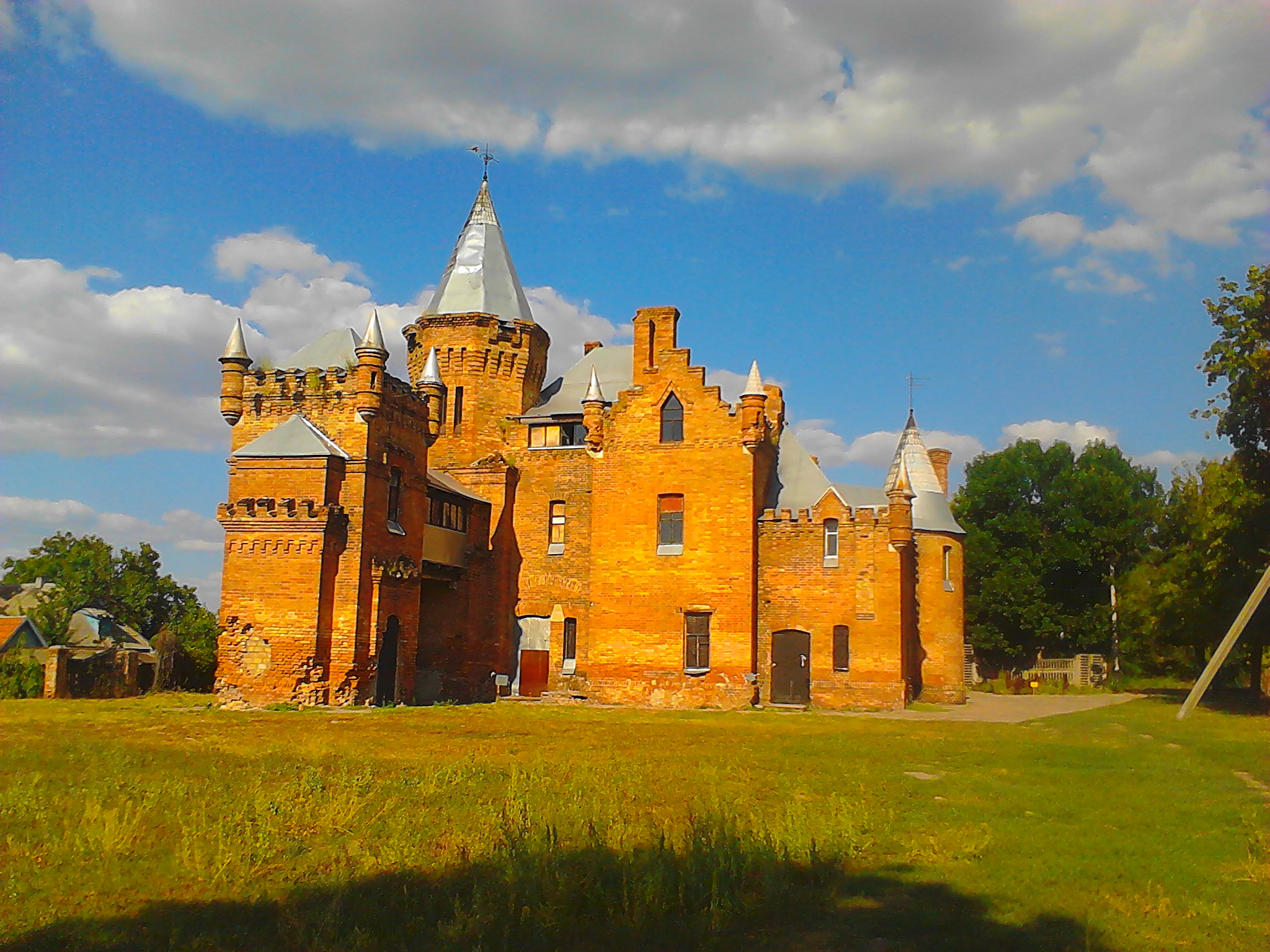
Popov’s Castle, Zaporizhzhia Region, in 2013. Photo (CC-by-SA-3.0): Mansour abu Siam / Wikimedia Commons.
On March 7, the museum’s director Anna Holovko wrote on Facebook that several of the buildings had been damaged, though did not attribute blame. So too did Vlad Moroko, head of the cultural department of the Zaporizhzhia Regional Administration – though he directly blamed Russia for the damage.
Both Holovko and Moroko posted images of damage to a tower in the palace walls and to a modern dormitory building just behind it. As these buildings both face south-west, it is possible that the attack originated from this direction.
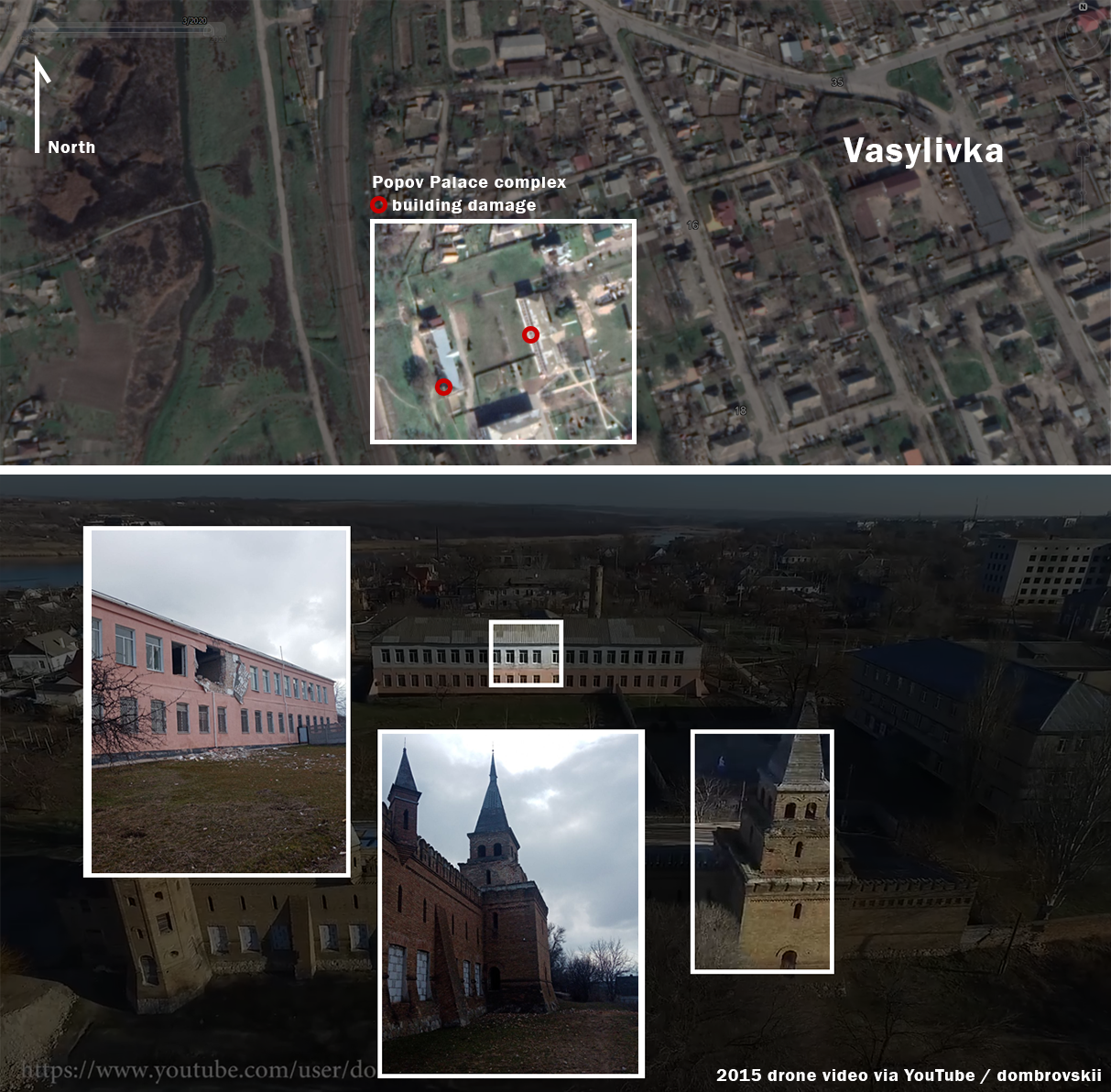
Diagram by Jake Godin / Newsy. Images from Facebook, reproduced for analytical purposes only.
Six days later, on March 13, Holovko wrote on Facebook that “occupiers” had “ransacked the museum” that day and “stolen everything they could, taking it away in bags”, breaking doors and windows in the process. In a further Facebook post, Moroko stated that Russian soldiers had stolen an antique marble toilet bowl from the museum.
The available open source evidence cannot confirm these reports of looting. However, it does indicate that Russian soldiers were present in Vasylivka by March 13.
On February 28, the town’s mayor Serhiy Kaliman stated in a video address that “we can see military vehicles approaching Vasylivka from all sides”, warning residents to head to basements in case of shelling. According to a video posted to Telegram, School No. 1 on Shevchenko Street was hit by artillery on March 1.
Another video recorded from the town centre appears to show that there were Russian soldiers and armour in Vasylivka by March 3. A voice in the attached video notes that the soldiers were carrying shopping bags and that they had looted shops.
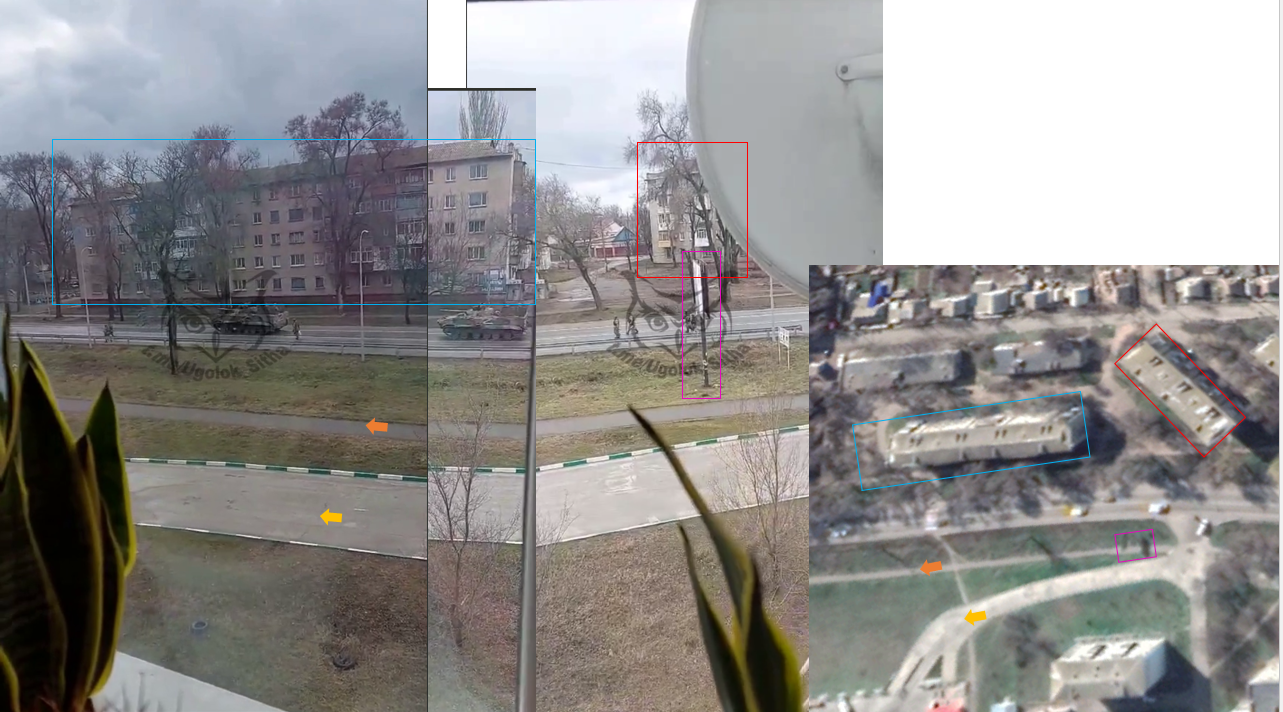
Geolocation of Russian soldiers in Vasylivka on March 3 to Melitopol-Zaporizhzhiya highway which passes through the town centre (47.438055,35.294866). Images from Telegram and Google Maps.
On March 7, the Zaporizhzhia Regional Defence Administration announced on Telegram that Vasylivka was “temporarily occupied”. Another video posted to Twitter from the town on March 8 showed the aftermath of intense fighting, including destroyed armour and the corpse of a soldier. The user claimed that the video shows three destroyed Russian vehicles, yet it appears to show the remains of just one BMP-3, an infantry fighting vehicle largely operated by the Russian military.

Geolocation of the aftermath of fighting in Vasylivka on March 8 to Berehova Street, (47.447613, 35.278220), approximately 150 metres from Popov’s Palace. Images from Telegram and Google Earth Pro.
Bellingcat geolocated the video to Berehova Street in central Vasylivka – just one street away from Popov’s Palace. It therefore appears that there was some military activity in the immediate vicinity of the palace just days before it was reported as looted – by which time Vasylivka was widely reported as under Russian control.
Just as in other occupied towns, Russian authorities have started to “mark territory” in Vasylivka, removing symbols of Ukrainian statehood. On May 8 footage appeared on Telegram of workers removing the Ukrainian coat of arms from the city administration building. The Russian flag was raised over the city council building on April 25. Moreover, on May 12 the pro-Russian local administration announced that a police station had started operation on “Lenin Street 10” (officially Soborna Street) – suggesting a reversal of the decommunisation of street and place names.
While it now seems that the Russian authorities are currently in control of Popov’s Palace, the state of its interior is unknown.
A Loss Beyond Measure
Compared to the scale of loss of human life – Russia’s invasion has killed thousands of civilians – the damage to these monuments might be expected to pale into insignificance. But experts in Ukraine’s cultural field told Bellingcat that these two tragedies – the cultural and the humanitarian – are deeply intertwined.
“Remember that the cultural field in Ukraine is basically a female profession. Every museum had a team where many women had to take care of their children – a big enough issue. So many fled. It’s a dramatic dilemma: do you protect your institution or your child?”, asks Ostrovska-Liuta, director of the Arsenal Centre in Kyiv.
“The nature of preservation focuses on material structures, but there are no structures without people. People who have lived and worked in them, the people who watch over them today. They also symbolise places – Kharkiv, Chernihiv – where people have been killed”, explained Sofia Dyak, director of the Centre for Urban History in Lviv.
Moreover, she says, destruction of smaller sites across Ukraine has raised their profile across the country, strengthening a sense of belonging and affiliation with them. The viral images of the statue inside the charred Skovoroda Museum attest to this fact.
“The price is terrible, and these losses make us rethink what is canon. Heritage is an expanding concept – it’s not just a famous palace or a cathedral. Neither is it just bureaucratic – what about family albums which burn inside houses? That’s not listed heritage, but it’s no less important”, added Dyak.
Indeed, some counts of Ukraine’s cultural heritage sites far exceed official lists. The Smithsonian’s Cultural Rescue Initiative, for example, puts the number at more than 28,000 — of which 458 are potentially at risk. Furthermore, as one paper from the Smithsonian shows, Russia has also erected new monuments to mark its ownership of occupied Ukrainian land – and its history.
While such actions are self-evidently deliberate, proving the destruction of cultural heritage sites as premeditated is more difficult.
“You’re aiming to obliterate a neighbourhood and there happens to be a museum there. Is it intentional? Well, there was certainly the intention to aim artillery and bombs. Were they going after a particular statue or painting? That, we can’t get to with the data we have, explained Dr. Richard Kurin, distinguished scholar and ambassador-at-large of the Smithsonian Institution, in an interview with Bellingcat.
“But providing the data can at least offer a set of clues” as to whether that may or may not be the case, Kurin added.
Experts also say looting risk to cultural heritage sites is not over even when the active phase of a conflict ends.
“The story isn’t over when the first wave of destruction happens”, cautions Dr. Katharyn Hanson, a cultural heritage preservation scholar at the Smithsonian’s Museum Conservation Institute, drawing on cases from Iraq and Syria. “Often destruction of a cultural site takes place after there’s been a theft, and may be an attempt to cover up that theft”, she adds.
According to a study by the Kyiv School of Economics, Russia’s invasion may have already cost Ukraine US$600 billion. In the coming reconstruction, says Ukrainian cultural critic Kateryna Botanova, heritage sites may not be a priority – compounding their loss.
“Even if the war stops today, it’s most likely that funding for cultural institutions will either hardly be available or not be at all because of the scope of the destruction and the need for economic and infrastructural recovery… it’s not a hospital or a railroad”, explained the Switzerland-based writer in an interview with Bellingcat.
“So we have to think about the culture which won’t happen in the future as a result of this, as well as human resources in our sector because so many people have fled the country”, she added.
As long as the invasion continues, the fate of Ukraine’s cultural heritage sites hangs in the balance. It is likely that even more will be destroyed or damaged as Russia’s assault on the Donbas region continues, at an ever-rising cost.
Jake Godin (Newsy) contributed reporting, research and analysis. Carlos Gonzales, Michael Sheldon and Narine Khachatryan also contributed to this report.
